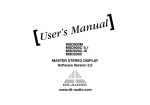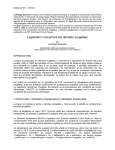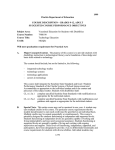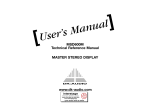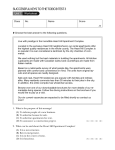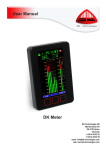Download DK-Audio MSD100 User`s manual
Transcript
l a u n a M s ’ r e s U [ MSD100 MSD100AES/SA MSD100T/SA MASTER STEREO DISPLAY www.dk-audio.com ] MSD100 Series - User’s Manual Copyright © 1995, 1997, 2002, DK-Audio, Herlev All rights reserved. No part of this publication may be reproduced or distributed in any form, or by any means, without prior written consent from DK-Audio A/S, Denmark. Trademarks Analog Devices is a registered trademark of Analog Devices, Inc. USA Crystal is a registered trademark of Crystal Semiconductor Corp., USA Note: This manual covers all MSD100 Series models. The main text refers to the MSD100 but applies to all models. Special notes, subsections and tables are provided to describe operational features that are unique to specific models. MSD100 Series - User’s Manual CONTENTS 1. Introduction 1.1 1.2 1.3 1.4 Using This Manual . . . . Notation Conventions . Related Documentation If You Need Help . . . . . . . . . . . . . . . . . . . . . . . . . . . . . . . . . . . . . . . . . . . . . . . . . . . . . . . . . . . . . . . . . . . . . . . . . 2 3 4 4 Audio Metering . . . . . . . . . . . . . . . . . . . . . . . MSD100 Applications . . . . . . . . . . . . . . . . . . Physical Overview . . . . . . . . . . . . . . . . . . . . . Audio Inputs . . . . . . . . . . . . . . . . . . . . . . . . . Power Supply . . . . . . . . . . . . . . . . . . . . . . . . Model Comparison Summary . . . . . . . . . . . . 5 5 6 6 6 8 2. Overview 2.1 2.2 2.3 2.4 2.5 2.6 3. Installation 3.1 Mounting . . . . . . . . . . . . . . . . . . . . . . . . . . . . 9 3.1.1. Mounting for Horizontal and Vertical Adjustment . . . . . . . . . . . . . . . . . . . . 9 3.1.2 Mounting for Horizontal Adjustment Only . . . . . . . . . . . . . . . . . 9 3.2 Audio Connections . . . . . . . . . . . . . . . . . . . 10 3.3 Power Connections . . . . . . . . . . . . . . . . . . . 11 4. Operation 4.1 Main Display and Control Keys . . . . . . . . . . 12 4.1.1 Initial Display at Power Up . . . . . . . . . 13 4.1.2 Function Keys . . . . . . . . . . . . . . . . . . 13 4.1.3 Additional Information Displayed on Digital Models . . . . . . . . . . . . . . . . . . 13 4.2 Phase Correlation Meter . . . . . . . . . . . . . . . 14 4.3 Audio Vector Oscilloscope . . . . . . . . . . . . . . 14 4.4 Peak Programme Meter (PPM) . . . . . . . . . . 15 4.4.1 International PPM Scales Supported . 15 4.5 Level Meters . . . . . . . . . . . . . . . . . . . . . . . . 16 4.6 Adjusting Input Gain (20 dB) . . . . . . . . . . . . 16 4.7 Using the Utilities Menu . . . . . . . . . . . . . . . . 16 4.7.1 Adjusting Brightness . . . . . . . . . . . . . . 17 4.7.2 Adjusting Viewing Angle (Contrast) . . . 17 4.7.3 Selecting Inverted Display . . . . . . . . . 18 MSD100 Series - User’s Manual 4.8 Selecting PPM Options . . . . . . . . . . . . . . . . 4.8.1 Selecting Preferred PPM Scale . . . . . . 4.8.2 Selecting the PPM Reference Level . . 4.8.3 Using the LED Overload Indicators . . . 4.8.4 Using the PPM Peak Hold Function . . 4.8.5 Using the PPM FAST Mode . . . . . . . . 4.9 Changing Default Settings . . . . . . . . . . . . . . 4.10 Bitstream Status Display . . . . . . . . . . . . . . 4.10.1 AES/EBU Decoding Mode . . . . . . . . 4.10.2 Consumer Decoding Mode . . . . . . . . 4.10.3 Displaying Channel Information . . . . 4.11 Spectrum Analysers . . . . . . . . . . . . . . . . . . 4.11.1 FFT Spectrum Analyser . . . . . . . . . . 4.11.2 1/3-Octave Spectrum Analyser . . . . . 18 18 19 19 19 20 20 21 21 23 23 23 23 24 Appendix A. Specifications A.1 A.2 A.3 A.4 A.5 A.6 Power Supply . . . . . . . . . . . . . . . . . . . . . . . Cabinet Dimensions . . . . . . . . . . . . . . . . . . Level Meter . . . . . . . . . . . . . . . . . . . . . . . . Phase Correlation Meter . . . . . . . . . . . . . . . Audio Vector Oscilloscope . . . . . . . . . . . . . LCD Display . . . . . . . . . . . . . . . . . . . . . . . . 25 25 25 26 26 26 Glossary Terms, Abbreviations, Acronyms . . . . . . . . . . . . 27 Product Registration Form Registration Card . . . . . . . . . . . . . . . . . . . . . . . 30 MSD100 Series - User’s Manual List of Tables Table Table Table Table Table Table 2-1 2-2 3-1 3-2 4-1 4-2 MSD Rear Panel Connections . . . . . . . 6 MSD Comparison Summary . . . . . . . . . 8 MSD Series Audio Connections . . . . . 10 MSD Supply Voltage Specifications . . 11 Ideal Stereo and Mono Signals . . . . . . 14 Data Information for AES/EBU Mode . 22 List of Figures Figure 1-1 MSD Master Stereo Display . . . . . . . . 1 Figure 4-1 MSD Main Display . . . . . . . . . . . . . . 12 Figure 4-2 MSD100AES/SA w/Sampling Frequency . . . . . . . . . . . . . . . . . . . . 13 Figure 4-3 MSD100 Displays for Signal Conditions . . . . . . . . . . . . . . . . . . . . 15 Figure 4-4 Available PPM Scales . . . . . . . . . . . . 16 Figure 4-5 Set Brightness/ INV Menu . . . . . . . . . 17 Figure 4-6 Set Viewing Angle Menu . . . . . . . . . . 17 Figure 4-7 Set Set up Utility Menu . . . . . . . . . . 21 Figure 4-8 FFT Spectrum Analyser . . . . . . . . . . 24 MSD100 Series - User’s Manual 1. INTRODUCTION This section provides a description of the MSD100 Series, lists related documentation and notation conventions, and provides product support contact information. The DK-Audio MSD100 Master Stereo Display Series models are universally recognised professional audio metering system for broadcast and studio applications. The MSD100 Series supplements the human ear by providing a visual representation of audio level, phase, stereo imaging and more. The entry-level MSD100 is shown in Figure 1-1. The MSD Series models covered in this manual are: • MSD100 • MSD100AES/SA • MSD100T/SA Figure 1-1. MSD100 Master Stereo Display ☞ Note: This manual covers all MSD100 Series models listed above. The main text refers to the MSD100 but applies to all models. Special notes are provided to describe operational features that are unique to specific models. 1 MSD100 Series - User’s Manual The MSD100 Series models deliver monitoring capabilities beyond traditional instruments such as bar graphs, LEDs and oscilloscopes. All MSD100 Series units provide the following basic functions: • • • • • • Phase Meter Audio Vector Oscilloscope Level Meter with selectable PPM/VU scales Selectable reference level LED overload Indicator Peak Hold 2 1.1 Using this Manual This manual contains information and instructions necessary to install, configure and operate the MSD100, MSD100AES/SA and MSD100T/SA. It provides step-bystep instructions you must perform to install and operate your MSD100 Series model successfully. This manual contains the following information: Section 1 Introduction. Includes a brief description of the MSD100 Series, lists related documentation, provides product support contact information. The MSD100T/SA adds the following features: • Spectrum Analyser • Transformer balanced audio inputs with XLRs Section 2 Overview. Describes the MSD100 functions, hardware components, physical enclosure, and connectors. The MSD100AES/SA adds the following features: • Spectrum Analyser • Digital Data Readout Section 3 Installation. Provides instructions on how to install the unit and connect audio and power cables. MSD100 Series - User’s Manual Section 4 Section 5 Section 6 Set-up and Operation. Provides instructions on how to operate the MSD and use the main display, control keys, phase correlation meter, audio vector oscilloscope, and peak programme meter. It describes how to interpret displayed data, adjust PPM peak hold meters, input gain, utilities, brightness, and viewing angle. Digital AES/EBU Versions. Describes the operation of the bitstream status display on the digital audio MSD100AES/SA model. Spectrum Analyser Versions. Describes the operation of the Spectrum Analyser of the MSD100T/SA and MSD100AES/SA models. Appendix A Specifications. Provides the technical and physical specifications for the MSD unit. Glossary 3 Glossary. Provides full spelling of acronyms and abbreviations and the definitions of special industry terms used in this manual. Product Registration Card. This page can be used Registration if the registration card is missing. Either the form or the card can be mailed or faxed to DK-Audio. 1.2 Notation Conventions Before you begin working with the MSD100, familiarise yourself with the notation conventions used in this manual. Convention/Symbol ☞ ! Caution Meaning/Example Used together with italic type to point out important information and notes. Important cautions and safetyrelated information, such as “Never apply power while the housing is removed”. MSD100 Series - User’s Manual Boldface Type Italic type Keys you must press, such as [LEFT], [UTIL], [CAL], [DEFAULT] and [EXIT] keys. Emphasises operational differences of specific models, such as This function is not available on the MSD100AES/SA. 1.3 Related Documentation The Audio Metering book provides additional information about related technologies, and is available from your local dealer. • Audio Metering, Eddy Bøgh Brixen, Broadcast Publishing & DK-Audio A/S, Denmark 2001 4 1.4 If You Need Help If you need assistance while working with your MSD100 Series product, please contact your local dealer or tech.support at DK-Audio: Telephone Fax Mail registration E-mail Web address +45 44 85 02 55 +45 44 85 02 50 DK-Audio A/S, Marielundvej 37D DK-2730 Herlev – Denmark [email protected] www.dk-audio.com You can access the following Technical Support information from our web site: • Product Specifications • Software downloads (Not available for MSD100-series) • User’s Manuals • FAQ (Frequently Asked Questions) • Direct contacts MSD100 Series - User’s Manual 5 2. Overview Audio vector oscilloscope Picture of audio signal indicating mono or stereo patterns This section provides an overview of MSD100 audio metering functions, applications, a physical description and a summary comparison table. 2.2 MSD100 Applications 2.1 Audio Metering The small physical size and versatility of the Master Stereo Display makes it ideally suited for: The DK-Audio MSD100 Master Stereo Display Series provides producers, sound engineers and technicians with an objective visual representation of audio characteristics. By supplementing the human ear with meters and scopes based on international standard measurement scales, the risk of over-reliance on subjective criteria is minimised. All models in the Master Stereo Display Series ranging from the simple monochrome version to the multi-channel colour version provide the following basic functions: • • • • • FUNCTION Phase meter DISPLAY Average phase relationship between two audio signals • • • • Level meter Level of signal with peak and overload protection with several selectable international scales and reference levels Master metering of any mixing console Studio and broadcast facilities OB-Vans Hard disc recording and editing systems Home studios The MSD100 Series provides serious audio professionals with these essential features backed by a 2-year warranty: Phasemeter Audio vector oscilloscope Level meter with 6 selectable PPM/VU scales Individually selectable input reference levels with an additional 20dB of input gain (100, 100T/SA) • LED overload indicator MSD100 Series - User’s Manual • Peak hold • Simultaneous display of stereo information and audio levels • Softkey selectable PPM characteristics • Support for most international standards • Digital processing, eliminating scale errors • Storage of all user defined parameters in NV-RAM • Long life CCT backlight (15.000 hours) • Digital Data Readout (100AES/SA) • FFT and 1/3 octave spectrum analyser (100T/SA and 100AES/SA) 2.3 Physical Overview Each MSD100 model is housed in a cabinet measuring 179 mm wide x 129 mm high (without bracket) x 39 mm deep. The display area is 120 x 92 mm. 2.4 Audio Inputs The rear-panel audio connection and signal types vary by model as described in Table 2-1. 6 Model Connector Type Signal type MSD100 RCA phono plugs Unbalanced stereo MSD100AES/SA Female XLR sockets Balanced AES/EBU (digital) MSD100T/SA Female XLR sockets Balanced TABLE 2-1. MSD100 SERIES REAR PANEL CONNECTIONS 2.5 Power Supply The 2.1 mm power input connector on the rear of the MSD100 cabinet accepts 12-30V DC. The power supply is based on both switch-mode and linear regulation principles and accepts both AC and DC inputs. MSD100 Series - User’s Manual Recommended supply voltages are: • 12 to 30V DC • 12 to 20V AC, 50Hz An optional 230V power supply, such as the Model MSD100-PS/0, is available with the following typical specifications: Input: 100-240V AC, 47-63 Hz, 1.0A Output:15V DC, 1.0A, 15W max. ! Caution Caution: High voltage for the LCD background light is generated internally. Use special care when servicing as 600V AC is present on the circuit board. 7 Supply voltage range Dimensions (mm) HxWxD MISCELLANEOUS Phasemeter Audio vector oscilloscope PPM/VU Level meter scales FFT Spectrum Analyser 1/3 octave spectrum analyser ANALYSER LED overload Audio connectors Analogue stereo outputs Digital AES/EBU inputs Digital AES/EBU outputs Analogue stereo inputs INTERFACE Display Type Colour/Mono Display view area (mm) DISPLAY + + - + + + + 6 1 Link (loop through of dig. input + XLR - LCD Mono 120x92 MSD100AE/ SA 12-20 V AC / 12-30 V DC 129x179x39 + + 6 + XLR 1 (Transformer Balanced) - LCD Mono 120x92 MSD100T/ SA + + 6 + Phono 1 (Unbalanced) - LCD Mono 120x92 MSD100 TABLE 2-2. MSD100 COMPARISON SUMMARY Table 2-2 provides a comparison of MSD100 models. 2.6 Model Comparison Summary MSD100 Series - User’s Manual 8 MSD100 Series - User’s Manual 3. Installation This section describes how to mount the MSD100 and connect audio and power. 3.1 Mounting All MSD100 models are supplied with the following accessories for easy mounting on any console or desk: • Circular base plate • Bracket (U-form) • 3 finger screws with washers The bracket facilitates horizontal and vertical adjustment for optimum viewing. 3.1.1 MOUNTING FOR HORIZONTAL AND VERTICAL ADJUSTMENT To mount the MSD100 for greatest viewing flexibility: 1 Attach the base plate to your console or work surface using two 4mm wood screws (or alternative). 2 Secure the bracket to the base plate with the supplied finger screw. 3 Insert a star washer between the base plate and the bracket. 4 Attach the MSD100 to the bracket using the two finger screws. 5 Insert star washers between the MSD100 and the bracket to ensure a firm grip. 3.1.2 MOUNTING FOR HORIZONTAL ADJUSTMENT ONLY To mount the MSD100 more firmly, allowing horizontal adjustment only: 1 Secure the bracket directly to the console or work surface using two 4 mm screws (not supplied). 2 Attach the MSD100 to the bracket using the two finger screws. 3 Insert star washers between the MSD100 and the bracket to ensure a firm grip. 9 MSD100 Series - User’s Manual 3.2 Audio Connections For all MSD100 models, please observe the following precautions: • Use standard audio signal cable or similar • Ensure that all connections are firmly secured • Allow sufficient loose cable for the unit to be tilted and turned 10 TABLE 3-1. MSD100 SERIES AUDIO CONNECTIONS Model MSD100 Socket Type Pinouts Input Signal RCA-phono Shield – ground Analogue sockets Pin – signal Unbalanced Marked [L] Left stereo and [R] Right MSD100AES/SA Female XLR sockets Pin 1 = Ground Pin 2 = Signal Pin 3 = Signal Note: A male (IEC269-12 XLR socket is compliant) available for Note: Observe routing sigthat signals on nals to other pins 2 and 3 are equipment. “in phase” in the digital mode. Rear-cabinet connector types vary by model, as shown in Table 3-1. MSD100T/SA Female XLR sockets Inputs are transformer balanced Digital Balanced AES/EBU or SP/DIF Pin 1 = Ground Analogue Pin 2 = In Phase Pin 3 = Out of Balanced Phase (IEC268-12 compliant) MSD100 Series - User’s Manual 3.3. Power Connection Each MSD100 Master Stereo has a 2.1 mm DC-power socket on the rear of the unit. Power can be fed from a standard power adapter or from an appropriate power source in your console or desk. Table 3-2 lists the AC and DC operating range and operating recommended supply voltages. TABLE 3-2. MSD100 SUPPLY VOLTAGE SPECIFICATIONS Operating range 12 to 20V AC, 50 Hz 12 to 30V DC Recommended 12V AC, 50 Hz 12V DC supply voltage A standard 100-240V AC, 47-63 Hz, 1-0 A power adapter can be supplied as an option. Order no. MSD100-PS/0 11 MSD100 Series - User’s Manual 12 4. Operation 4.1 Main Display and Control Keys This section provides operational information for MSD100 common functions available on all MSD100 models: The MSD100 Main Display, shown in Figure 4-1, shows the following information simultaneously: • • • • Phase Meter Audio Vector Oscilloscope Level Meter Menu text line for soft keys Main display Phase meter Audio vector oscilloscope Peak programme meter and supported PPM scales Left Centre Right Bottom It also describes operation of unique functions available only on specific MSD100 models: • Bitstream status display • Spectrum analyser Figure 4-1. MSD100 Main Display MSD100 Series - User’s Manual 4.1.1 INITIAL DISPLAY AT POWER UP After power up, the LCD panel initially displays the software version installed, for example MSD100 1.54. 4.1.2 FUNCTION KEYS The three black keys operate the functions displayed in the menu text line directly above them. For example, the left function key toggles between SPECT and EXIT. An empty black box displayed next to a function in the menu text line, such as shown below, indicates that this function is disabled or OFF. 13 4.1.3 ADDITIONAL INFORMATION DISPLAYED ON DIGITAL MODELS In addition to the phase meter, audio vector oscilloscope, level meter and menu text line, the digital MSD100AES/SA models also show the sampling frequency. Figure 4-2 shows the frequency of . ☞ Note: If no signal is present, this numeric field will indicate [OPEN]. Clicking the function key directly below 20dB toggles between ON (black box) and OFF (empty box) status. This operation applies to other functions such as Left, Right, Hold and Fast. The function keys are also used to increase and decrease values as shown below. Figure 4-2. MSD100AES/SA with Sampling Frequency MSD100 Series - User’s Manual 14 4.2 Phase Correlation Meter Table 4-1 and Figure 4-3 describe optimum stereo and mono signals measurements and corresponding displays. The Phase Correlation Meter displays the average phase relationship between two audio signals, and indicates mono, stereo or reverse-phase on a centre-zero scale. ☞ TABLE 4-1. IDEAL STEREO AND MONO SIGNALS 4.3 Audio Vector Oscilloscope Signal Ideal Stereo [0] Mono [+1] Display/Comment Perfect circle or ball. See Figure 4-3. This representing a random distributed phase with maximum ambient effect. Vertical straight line. See Figure 4-3. A [0] to [-1] indicates signal with reversed phase components approaching a horizontal line displayed in Fig. 4-3. Note: Never allow a negative reading if the signal is to be reproduced in mono. Note: Input signals below a predefined threshold will force the indication toward zero. Only major phase components are considered. The audio vector oscilloscope, also know as a stereo image monitor or goniometer, provides continuous Lissajous-format display of the phase and amplitude of the stereo signal. An ideal stereo signal has phase and amplitude components randomly distributed. The best example of a true stereo signal is from an audience applauding during a live recording. This is represented graphically on the oscilloscope as a perfect circle or ball, as shown in Figure 4-3. See the examples of phase meter and oscilloscope displays under different signal conditions in Figure 4-3. MSD100 Series - User’s Manual Ideal Stereo Signal Mono Signal Reversed Phase Stereo Signal 15 • Using a full-wave rectifier with integration time set for highest amplitude without overloading the transmission link and for sufficient duration to avoid audible distortion. • Long return time to minimise viewer fatigue. 4.4.1 INTERNATIONAL PPM SCALES SUPPORTED Left Signal Right Signal Reversed Phase Mono Signal Figure 4-3. MSD100 Displays for Signal Conditions The MSD100 supports four different international PPM scales in accordance with IEC 268-10, IEC 268-17, and DIN 45406. This instrument also complies with standard VU and two digital scales. Table 4-2 lists the scales for all units 4.4 Peak programme Meter The peak programme meter (PPM) directly measures the quasi-peak levels of complex electrical signals, such as music and speech. The PPM accomplishes this by: • Maintaining constant sensitivity of the device, optimising use of the transmission channel and recording medium. TABLE 4-2. AVAILABLE SCALES Type I Nordic Type IIA BBC Type IIB EBU Type DIN Type VU Type DMU1 Digital Type DMU2 Digital MSD100 Series - User’s Manual 16 4.6 Adjusting Input Gain [20dB] TYPE I TYPE IIA TYPE IIB NORDIC BBC EBU DIN VU DMU1 DMU2 Figure 4-4. Available PPM Scales Use the [UTIL] menu to select the different scales shown in Figure 4-4. You can increase the input sensitivity to obtain the best possible dynamic range and accuracy for a weak signal. To increase the input sensitivity by 20dB: Press the function button for . The checkbox turns black. ☞ Note: The input gain function is not available on the digital MSD100AES/SA model. 4.7 Using the Utilities Menu You can use the Utilities [UTIL] menu to: 4.5 Level Meters The MSD100 Level Meter provides these additional functions: • • • • “Flying” Peak indicators Peak Hold LED-overload indicators Individual reference level selection • • • • Adjust display brightness Adjust contrast for viewing angle Select PPM scales Select inverted display ☞ Note: The high-quality LCD display reacts quickly to light and angle adjustments, but may still require that you allow several seconds for the display to stabilize between adjustments. MSD100 Series - User’s Manual 4.7.1 ADJUSTING BRIGHTNESS 17 4.7.2 ADJUSTING VIEWING ANGLE (CONTRAST) To adjust the brightness of the display: To adjust the contrast of the display: 1 Press [UTIL]. Figure 4-5. Set Brightness/Inv Menu 2 Press [LIGHT]. The Set Brightness menu is displayed as shown in Figure 4-4. 3 Press function keys for and to increase or decrease brightness. This adjusts the background lighting for the best viewing clarity. 4 When finished, press [EXIT] to return to the Main Menu. Figure 4-6. Set Viewing Angle Menu 1 Press [UTIL]. 2 Press [ANGLE]. The Set Viewing Angle menu is displayed as shown in Figure 4-5. 3 Press function keys for and to increase or decrease contrast. This adjusts the angle (contrast) for the best possible viewing angle. 4 When finished, press [EXIT] to return to the Main Menu. MSD100 Series - User’s Manual 18 4.7.3 SELECTING INVERTED DISPLAY 4.8.1 SELECTING PREFERRED PPM SCALE To reverse the colours so that the screen will appear black with white text and figures: You can select from up to seven international scales, described earlier in Table 4-2. To obtain the complete set of specifications, refer to the following recommendations: 1 Press [UTIL]. 2 Press [LIGHT]. The Set Brightness/ Inv Menu is displayed as shown earlier in Figure 4-4. 3 Press function key for to increase to [99]. The display becomes inverted. To toggle between inverted and normal display, press the key again. 4 When finished, press [EXIT] to return to the Main Menu. 4.8 Selecting PPM Options The Peak Programme Meter Menu indicates the level of the audio signal for each channel. The PPM includes Flying Peak, Peak Hold, Fast Peak and 20 dB gain options and includes seven international scales. • • • • • • • IEC 268-10 Peak Programme Level Meters DIN 45406 Pflichtenhefte 3/6 IEC 68-17 VU Meter Nordic N9 CCIT Report 292-2 CCIT BS6840 part 10 See Figure 4-4 for available PPM scales. To select the preferred PPM scale: 1 Press [UTIL]. 2 Press [PPM]. 3 Press [SCALE]. The Scale Menu is displayed with three options: [PREV], [NEXT] and [SELECT]. 4 Press [NEXT] or [PREV] as needed to move forward or backward through the scale types displayed in the menu text line: I, IIA, IIB, DIN, VU, DMU1 and DMU2. MSD100 Series - User’s Manual ☞ Note: The last choice, REF, is for setting the reference (test) level for that scale. 5 When the preferred scale is displayed, press [SELECT]. The selected scale is displayed. 6 Press [EXIT] to return to the Main Menu. 4.8.2 SETTING THE PPM REFERENCE LEVEL After you select the preferred PPM scale, you can set the reference (test) level for that scale. To set the PPM reference level: 1 Perform Steps 1 through 5 under Selecting Preferred PPM scale. 2 After you press [SELECT], press the function keys for and to set the reference level. 3 After you set the level, press [EXIT] to return to the Main Menu. 19 4.8.3 USING THE LED OVERLOAD INDICATORS When an overload condition occurs, the following indicators activate simultaneously: • Two red LED overload indicators in the front plate illuminate. The LED indicators, located directly above the PPM bars, light up when the selected reference level for the scale is reached (for example at +6dB for Type I, Nordic scale). • Split bars appear in the PPM bars in the LCD display. 4.8.4 USING THE PPM PEAK HOLD FUNCTION The Peak HOLD function enables you to check the maximum signal level reached during and after a recording session. This helps you confirm that levels did not exceed specified limits. In the HOLD mode, the “flying” segments of the PPM bars indicate the highest bar-graph values attained since MSD100 Series - User’s Manual the last HOLD reset. HOLD reset is activated by reselecting any function scale. To select Peak HOLD: 1 Press [UTIL]. 2 Press [PPM]. 3 Press [OPTION]. The menu text line displays TOGGLE PPM OPTION. 4 Press [HOLD] to toggle the Peak HOLD function ON or OFF. When ON, the checkbox next to HOLD is black. 5 When finished, press [EXIT] to return to the Main Menu. 20 To select the FAST Mode: 1 Press [UTIL]. 2 Press [PPM]. 3 Press [OPTION]. The menu text line displays TOGGLE PPM OPTION. 4 Press [FAST] to toggle the FAST function ON or OFF. When ON, the checkbox next to FAST is black. 5 When finished, press [EXIT] to return to the Main Menu. 4.9 Changing Default Settings You can change the factory set default settings for brightness, viewing angle (contrast) and preferred scale. 4.8.5 USING THE PPM FAST MODE To change the default settings: You can use the FAST mode to set the PPM integration time to zero, making the bar graphs indicate peak values of the input signal. ☞ Note: When using a steady sinusoidal signal input, the bar graphs respond the same with or without FAST mode. 1 Power off the unit. 2 Press and hold [UTIL] key (middle key) while powering up the unit. The Set Up Utility menu is displayed with [CAL] and [DEFAULT] options as shown in Figure 4-6. MSD100 Series - User’s Manual 21 4.10 Bitstream Status Display The Bitstream Status Display is used for viewing status information for each AES/EBU channel, provided that this information is available in the signal. This display is included in MSD100AES/SA. 4.10.1 AES/EBU DECODING MODE Table 4-3 lists the Bitstream Status Display information for the AES/EBU (Professional) decoding mode: Figure 4-7. Set Up Utility Menu 3 Press [DEFAULT] and follow procedures in this section for adjusting settings for brightness, viewing angle (contrast) or preferred scale. 4 Turn off the power again. The new settings will be stored in memory as the new defaults for the next power up. Professional (AES/EBU) or Consumer protocol – IEC958 (S/PDIF) None - No emphasis indicated No emphasis, manual selection not possible Emphasis 50/15 µs Emphasis ITU J.17 Sampling rate lock not indicated Sampling rate of source not locked Not indicated Sampling rate = 48 kHz Sampling rate = 44.1 kHz Sampling rate = 32 kHz Not indicated Two channel One channel (mono) Primary/secondary mode (chan 1 is primary) Stereo, channel 1 is left channel Reserved for user-defined data One chan double sampling frequency One chan stereo: left-double sampling freq. One chan-stereo: right double sampling freq. Multi-channel, vector for byte 3 Not indicated 24-bits Other lengths Not referenced Signal source, for example DAT 1 Signal destination, for example AES 1 Time code (Hours:Minutes:Seconds and Frame Count) Blank = No time code Professional/ Consumer (Signal originates from Professional or Consumer eqpt) Emphasis Lock Sample Frequency Channel Mode (Information on relationship between audio signals in the two channels) User Bit (user-defined bit) Word Length Reference Signal Origin Destination H:M:S:Frame TABLE 4-2. DATA INFORMATION FOR AES/EBU MODE MSD100 Series - User’s Manual 22 MSD100 Series - User’s Manual 4.10.2 CONSUMER DECODING MODE To return to the main menu, press the same key again. The Bitstream Status display can also be used for decoding information from consumer-grade sources, using the protocol for Sony Philips Digital Interface S/PDIF) or IEC958. Although the structure of the stream is similar to AES/EBU, there are a number of important differences: 4.11 Spectrum Analysers • • • • • Audio or data state Copyright or non-copyright protection No emphasis or 50/15 µs emphasis 2 or 4-channel audio Device o Laser/optical o Signal processor o Magnetic tape or disk o Digital audio broadcast o Music instrument, microphone or other digital source 4.10.3 DISPLAYING CHANNEL INFORMATION To display the Channel A information, press [A DATA]. To display the Channel B information, press the same key again. 23 The FFT and 1/3 Octave Spectrum Analysers, used for determining frequency content of a signal, are included in the following MSD100 models: • MSD100T/SA • MSD100AES/SA The FFT-analyser is used as an accurate measuring tool, the 1/3-octave analyser shows the energy distribution of the signal. 4.11.1 FFT Spectrum Analyser The FFT Analyser uses a complex Fast Fourier Transform (FFT) algorithm that outperforms earlier analogue counterparts in the number of frequency bands and indication range. This analyser uses a 1024-band FFT algorithm to display the signal content between 44Hz and 20kHz, covering the dynamic range from –70 to +10dBu. These improvements make it possible to analyse frequency response, noise, and intermodulation (IM) distortion with much greater accuracy. MSD100 Series - User’s Manual Figure 4-6 shows the FFT Spectrum Analyser display on the MSD100/SA. To select the FFT Spectrum Analyser mode: 1 Press [FFT]. The FFT screen is displayed, as shown in Figure 4-6. Frequency indicators from 44 Hz to 20.000 Hz appear at the bottom of the screen. Level indicators, in 10dB increments from –70 to +10dBu appear on the left side. FIGURE 4-8. FFT Spectrum Analyser 24 2 Press [LEFT] or [RIGHT] to select the left or right input signal for FFT analysis. A small black square indicates the input selected. It toggles on or off as the key is pressed. ☞ Note: To analyse a mono signal, press both [LEFT] and [RIGHT] keys. 3 To return to the main menu, press [EXIT]. 4.11.2 1/3-OCTAVE SPECTRUM ANALYSER The 1/3-octave spectrum analyser provides real-time frequency analysis through a bank of filters, each with a relative bandwidth of 1/3 octave. This instrument provides a 31-bar display for numerical and graphical visualisation of the signal energy present at different frequencies across the audio range from 20Hz to 16kHz. The 1/3-octave spectrum analyser has many applications, including acoustical measurements in control rooms and PA system. The relative bandwidth filters are ideally suited for applications where the signal being measured must also be heard, since the ear perceives frequencies logarithmically. MSD100 Series - User’s Manual Appendix A A.3 Level Meter Specifications This appendix lists the performance specifications for the MSD100 Series. Reference indication Reference input voltage Reference input voltage adjustment Division of scale: A.1 Power Supply Supply voltage range DC current consumption @12V nominal supply Power dissipation Safety standard DC input: 12V to 30V AC input: 12V to 20V <600 mA 6.5W, approximately IEC 65 An optional 230V/50Hz AC power supply adapter is available. A.2 Cabinet Dimensions Width Height w/out bracket Depth 25 179 mm 129 mm 39 mm Amplitude frequency response, 3Hz–20 kHz Dynamic response a) Pflichtenheft 3/6: b) IEC 268-10 c) IEC 268-17 Overswing: Return time a) Pflichtenheft 3/6 b) IEC 268-10 0 dBm 1.55V +13 dB to –2 dB Type I Type IIA Type IIB Type DIN Type VU DMU1 DMU2 -42 dB 1 to 7 -12 dB - 50dB -20 dB -48 dB -60 dB ± 0.3 dB 3 ms / -3dB 5 ms / -2 dB VU: 300 ms None 20 dB / 1.5 s 20dB / 20 s to +12 dB to to to to to +12 dB +5 dB +3 dB +3 dB 0 dB MSD100 Series - User’s Manual Reversibility error None Input impedance, analogue >20 K ohm Input impedance, AES 1 K ohm Distortion introduced by None the PPM: Temperature range 0˚C to 45˚C Overload characteristics Maximum input level >21 dBu 90V RMS constant A.4 Phase Correlation Meter Indication range 1 to +1 A.5 Audio Vector Oscilloscope Automatic gain adjusting range Phase error between channels Display area 30 dB, default None 69 mm x 69 mm 26 A.6 LCD Display Resolution Pixel size Contrast ratio Viewing area Viewing angle Backlight CCFT, Lifetime, continuous driving, 50% intensity LCD surface brightness Backlight adjustment range 320 x 240 pixels 0.36 mm Type 8 120 x 92 mm 90 CR>3 White, CCFT Typical 15.000 hours Typical; 45 cd / m2 65% MSD100 Series - User’s Manual Glossary This glossary defines terms, acronyms and abbreviations used in this manual. Audio Vector Oscilloscope Instrument that provides continuous graphic display in Lissajous format of the phase and amplitude of a stereo signal. Also known as stereo image monitor or goniometer. Ampere; A unit of current measurement. Bandwidth The distance between the 3 dB cut-off frequencies on a response curve. Expressed in octaves or Hz. Alternating current. dB A AC Measure of audio level. Decibel; logarithmic level specification. ADC Analogue-to-Digital converter. A circuit that converts a digital signal to an analogue signal. Also expressed as A/D. dBu Audio Engineering Society. DC Measure of audio level. Logarithmic relation with a reference of 0.775 V. AES Direct current. AES/EBU The most widely used serial interface for audio stan dardised jointly by the Audio Engineering Society and European Broadcast Union. 27 EBU European Broadcast Union. Association of European radio broadcasting stations. MSD100 Series - User’s Manual Emphasis The requisite frequency correction upon recording and playback in order to obtain a proper frequency response. Fast Fourier Transform (FFT) A spectrum analyser using this complex FFT algorithm outperforms earlier analogue counterparts in the number of frequency bands and indication range. Goniometer See audio vector oscilloscope. 28 LED Light-Emitting Diode. Peak HOLD Circuit which for a shorter or longer period of time is in a position to maintain a peak value display. Peak Programme Meter (PPM) An instrument that provides direct measurement of the peak values of complex electrical signals. Phase The difference values which alternating current or alternating voltage runs through during a period. Hz Hertz; A frequency measurement in cycles per second. Inverted Display The reversal of LCD display colours so that the screen appears black with white text and figures. Phase Correlation Meter Instrument that displays the phase relationship between two input signals, such as left and right channels of a stereo program. Phono Consumer-type connector type using a centre conductor and outer shielding. MSD100 Series - User’s Manual PPM VU See Peak Programme Meter. RMS Root Mean Square; the effective value of a signal. Volume Unit. Measurement in dB for modulation with a reference of 1.23 V. Watt Measurement unit for power. S/PDIF Sony Philips Digital Interface defined as the consumer format. Spectrum Analyser An instrument used for determining frequency content (energy distribution) of a signal. Stereo Image Monitor See audio vector oscilloscope. V Volt; Unit of measure of electrical potential (voltage). XLR Professional audio connector plug type. 29 MSD100 Series - User’s Manual Registration Please fill in the registration card that was enclosed with your MSD product and mail or fax it to DK-Audio to obtain the latest information about new products. If your Registration Card is missing, you may use this page instead. Which features would you like to see in new versions of this model? Name: Company: Address: Comments: City: Country: Phone: Fax: E-mail: MAIL OR FAX TO: DK-Audio A/S Marielundvej 37D, DK-2370 Herlev, Denmark Unit Serial No: Purchase Date: Purchased from (dealer): Mail: Fax: [email protected] + 45 44 85 02 50 30




































